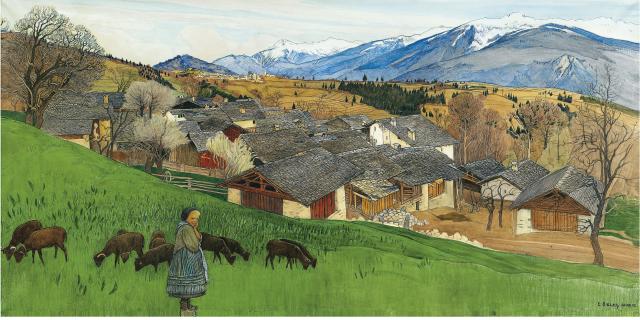In 1884 Ernest Biéler discovers Savièse and is immediately carried away by the area and its dazzling sunlight. He has his studio built there in 1900, and despite his many trips between Paris and Geneva, the artist will remain faithful to this Valaisan village until the end of his life. A meeting place for artists sharing the same concerns, Savièse represents for Biéler an archetypal region where one can readily find inspiration. Touched by both the beauty of the area and the village customs and mores practiced there, the artist will explore in numerous canvases this image of a life in harmony with nature, a trait that had disappeared from the industrial cities that took shape in the 19th century.
Through the choice of subject and the point of view adopted here, Savièse illustrates that nostalgia for our peasant roots and the quest to return to the primitivism of a bygone age. In this landscape portrait, Biéler breaks down a rural panorama into several pictorial planes, each related in someway to a characteristic of the region. First, a herd of goats tended by a child in traditional dress suggests the activities of the peasantry. This is a favourite subject for the painters of the School of Savièse and expresses for them the idea of a symbiosis between humans and their environment. Next the roofs of a hamlet appear, then a hill, and finally the snow-capped peaks forming a jagged profile against the bright sky.
The bucolic view the artist offers us gives an impression of something eternal and authentic. The elements of his composition make up an emblematic image of an ideal society preserved from the corruption that accompanies progress and modernity. This kind of depiction shares in the exaltation of patriotic sentiments that developed in the second half of the 19th century, fed by Switzerland’s mountain roots. The genre, moreover, helped to forge an identity for this region of Valais that endures to this day.
Through the choice of subject and the point of view adopted here, Savièse illustrates that nostalgia for our peasant roots and the quest to return to the primitivism of a bygone age. In this landscape portrait, Biéler breaks down a rural panorama into several pictorial planes, each related in someway to a characteristic of the region. First, a herd of goats tended by a child in traditional dress suggests the activities of the peasantry. This is a favourite subject for the painters of the School of Savièse and expresses for them the idea of a symbiosis between humans and their environment. Next the roofs of a hamlet appear, then a hill, and finally the snow-capped peaks forming a jagged profile against the bright sky.
The bucolic view the artist offers us gives an impression of something eternal and authentic. The elements of his composition make up an emblematic image of an ideal society preserved from the corruption that accompanies progress and modernity. This kind of depiction shares in the exaltation of patriotic sentiments that developed in the second half of the 19th century, fed by Switzerland’s mountain roots. The genre, moreover, helped to forge an identity for this region of Valais that endures to this day.
